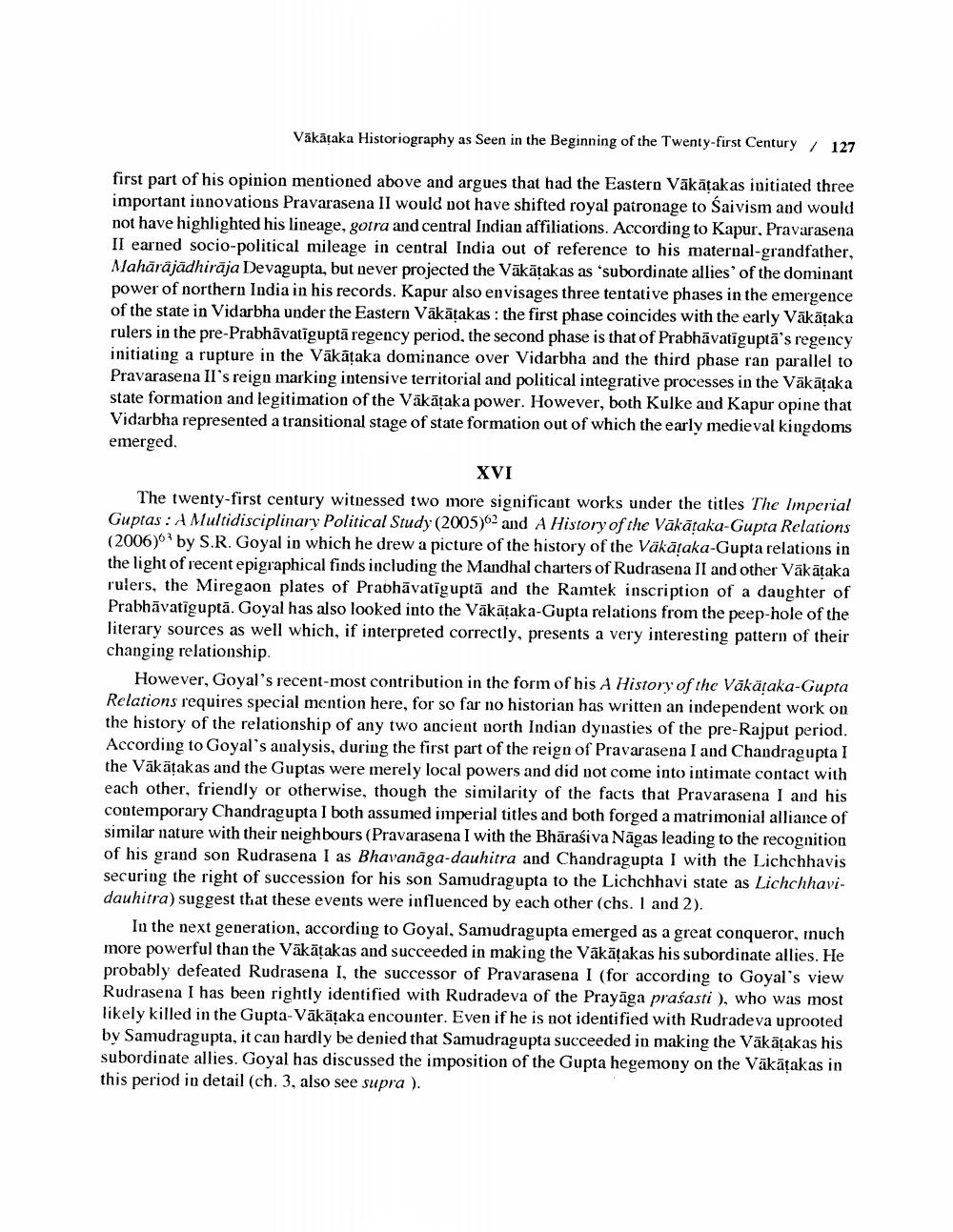________________
Vākātaka Historiography as seen in the Beginning of the Twenty-first Century /
127
first part of his opinion mentioned above and argues that had the Eastern Vākāțakas initiated three important innovations Pravarasena II would not have shifted royal patronage to Saivism and would not have highlighted his lineage, gotra and central Indian affiliations. According to Kapur, Pravarasena II earned socio-political mileage in central India out of reference to his maternal-grandfather, Mahāräjädhirāja Devagupta, but never projected the Väkätakas as subordinate allies' of the dominant power of northern India in his records. Kapur also envisages three tentative phases in the emergence of the state in Vidarbha under the Eastern Vākātakas : the first phase coincides with the early Vākātaka rulers in the pre-Prabhāvatīguptā regency period, the second phase is that of Prabhāvatiguptā's regency initiating a rupture in the Vākāțaka dominance over Vidarbha and the third phase ran parallel to Pravarasena II's reign marking intensive territorial and political integrative processes in the Vākātaka state formation and legitimation of the Vākāțaka power. However, both Kulke and Kapur opine that Vidarbha represented a transitional stage of state formation out of which the early medieval kingdoms emerged.
XVI The twenty-first century witnessed two more significant works under the titles The Imperial Guptas : A Multidisciplinary Political Study (2005)62 and A History of the Vākāțaka-Gupta Relations (2006) by S.R. Goyal in which he drew a picture of the history of the Väkätaka-Gupta relations in the light of recent epigraphical finds including the Mandhal charters of Rudrasena II and other Vākātaka rulers, the Miregaon plates of Prabhāvatiguptā and the Ramtek inscription of a daughter of Prabhāvatiguptā. Goyal has also looked into the Vākāțaka-Gupta relations from the peep-hole of the literary sources as well which, if interpreted correctly, presents a very interesting pattern of their changing relationship.
However, Goyal's recent-most contribution in the form of his A History of the Vākäraka-Gupta Relations requires special mention here, for so far no historian has written an independent work on the history of the relationship of any two ancient north Indian dynasties of the pre-Rajput period. According to Goyal's analysis, during the first part of the reign of Pravarasena I and Chandragupta I the Vākāțakas and the Guptas were merely local powers and did not come into intimate contact with each other, friendly or otherwise, though the similarity of the facts that Pravarasena I and his contemporary Chandragupta I both assumed imperial titles and both forged a matrimonial alliance of similar nature with their neighbours (Pravarasena I with the Bhāraśiva Nāgas leading to the recognition of his grand son Rudrasena I as Bhavanāga-dauhitra and Chandragupta I with the Lichchhavis securing the right of succession for his son Samudragupta to the Lichchhavi state as Lichchhavidauhitra) suggest that these events were influenced by each other (chs. 1 and 2).
In the next generation, according to Goyal, Samudragupta emerged as a great conqueror, much more powerful than the Vākāțakas and succeeded in making the Vākātakas his subordinate allies. He probably defeated Rudrasena I, the successor of Pravarasena I (for according to Goyal's view Rudrasena I has been rightly identified with Rudradeva of the Prayāga praśasti ), who was most likely killed in the Gupta- Vākätaka encounter. Even if he is not identified with Rudradeva uprooted by Samudragupta, it can hardly be denied that Samudragupta succeeded in making the Väkätakas his subordinate allies. Goyal has discussed the imposition of the Gupta hegemony on the Vākātakas in this period in detail (ch. 3. also see supra ).




